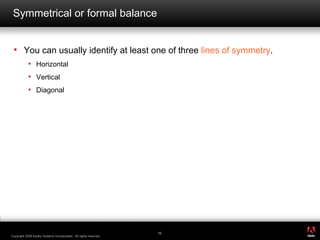Graphic Design Fundamentals
- 1. INTRODUCTION TO GRAPHIC DESIGN MOVEMENT, BALANCE, UNITY, CONTRAST, EMPHASIS, LINE, AND COLOR
- 2. Graphic design elements Graphic design elements are the building blocks of graphics. Line Color Shape Texture
- 3. Lines Lines can be straight or curved. How are lines used in the composition on this slide?
- 4. Color definitions Hue is another word for color. Chroma is the intensity or purity of color. Tint is a color mixed with white. Tone is a color mixed with gray. Shade is a color mixed with black.
- 5. Color and contrast Using color can enhance or detract from a composition. www.lighthouse.org/color_contrast.htm Color wheels help determine which colors are in greatest contrast. Use Kuler from Adobe Labs to try out new color schemes: http://kuler.adobe.com/
- 6. Color wheels Analogous colors are adjacent to each other on the color wheel. Complementary colors are opposite each other on the color wheel.
- 7. Color in design Use color to label or show hierarchy. Use color to represent or imitate reality. Use color to unify, separate, or emphasize. Use color to decorate. Use color consistently.
- 8. Shapes Shapes are enclosed objects that can be created by line or created by color and value changes that define their edges.
- 9. Texture Texture is the surface look of an object created by varying dark and light areas. Roughness Smoothness Depth
- 10. Graphic design principles Graphic design principles are ways in which elements are used together. Movement Balance Emphasis Unity
- 11. Movement Movement is the use of lines, color, and repetition to create the illusion of motion. Curved forms or lines Repetition of geometric forms Fuzzy lines or outlines
- 12. Lines Lines can indicate motion or direction. How are lines used in the composition on this slide?
- 13. Balance Balance is the act of comparing or estimating two things, one against the other, and the contrast between: Empty space (white space) and filled space Text and images Color and no colors and different colors Textures against flat colors
- 14. Balance in composition There are three different types of balance when using color, shape, and position: Symmetry Asymmetry Radial symmetry
- 15. Symmetrical or formal balance You can usually identify at least one of three lines of symmetry . Horizontal Vertical Diagonal
- 17. Examples of symmetrical balance
- 18. Examples of asymmetrical balance
- 19. Examples of radial balance
- 20. Unity Unity : The correct balance of composition or color that produces a harmonious effect. What is the focus of the message?
- 21. Emphasis Emphasis : To express with particular stress or force. What message is stressed here?
- 22. Summary The basis of good graphic design is use of design elements and their thoughtful application in the form of design principles. Clearly identify what you are trying to accomplish — use design to convey your message. Brainstorm alternatives.
Editor's Notes
- #14: Ask students if they can think of other types of balance: texture and no texture (smooth), size and scale, elements of a composition.
- #17: The rectangle has three lines of symmetry: Horizontal (blue), Vertical (red), Diagonal (yellow). The triangle has only one line of symmetry: center or, in this orientation, Vertical. You can draw two other lines of symmetry from any of the vertices to the center of the opposite side.





















